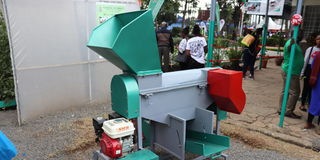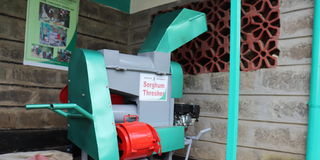Egerton's mechanized threshers target bean and sorghum farmers

A bean thresher invented by Egerton University.
Beans threshing has been a manual activity over the years and continues to be even after decades of mechanization.
This is always done by placing the harvested pods on a hard surface and hitting them with a stick to separate the grain from the pod and afterward manually winnowing. The dust from the beating and winnowing also leaves an itching effect on the body.
This has been the dilemma many bean farmers, especially women and youth, face every harvest season. Without mechanization, farmers have relied on family labour or expensive hired labour to thresh the grains.
Egerton University has invested in threshing technologies aimed at reducing food loss at the farm level to improve food security, safety, and labour productivity.
The bean thresher, a PhD innovation, is a motorized machine that can help remove the beans from the pods.
“Farmers often use primitive methods for threshing. Small-scale farmers every so often spread the grain on a surface and beat it with sticks, which leads to contamination with stones. Large-scale farmers have always employed tractors, driving over the beans to thresh them,” says Dr. Joseph Alele.

Dr Joseph Alele from Egerton university has spearheaded the threshers invention.
These methods are known to cause various types of post-harvest losses that impact the yields and income of farmers.
“Post-harvest losses occur at multiple stages when using traditional threshing methods. Firstly, beating grains with sticks or using tractors often leads to breakage, reducing the viability for future planting and is hardly accepted in the market,” explains the expert.
He continues, “Secondly, manual winnowing is inefficient and wasteful, with significant amounts of grain scattered and lost. Lastly, delays in threshing can result in seed deterioration or premature germination if storage conditions are poor. The threshing machine addresses all these issues, minimizing losses and preserving grain quality throughout the process.”
The thresher has several components- a hopper, rotating drum, sieve or screen, engine, blower/ fan, grain collector, dust outlet, and wheels that help with portability.
To use the machine, one puts the material into the hopper. Here, it's then beaten or rubbed between the drum and screen, separating the grains. These grains fall through, along with some chaff which is winnowed away.
It also has two separate waste outlets: one for empty bean pods and another for chaff. Once the chaff is blown the clean grains are collected from another outlet.
The Sh. 195,000 portable machine has a cleaning efficiency of about 95 percent and the breakages are as low as 3 percent and has an output of five -90kg threshed bags per hour.
Similarly to the bean thresher is the sorghum thresher whose components are almost similar with a few additions.

A sorghum thresher invented by Egerton University displayed during the Nakuru ASK show.
The sorghum thresher has three most important functions. It threshes, polishes, and winnows the grain.
“The threshing process separates the grain from the sorghum head in the rotating drum,” explains Dr. Alele. “Polishing occurs when the threshed grain enters the polisher, enabling the broom on the sorghum head to be removed, especially for brewing purposes. Finally, the sorghum is winnowed. This is particularly important because sorghum chaff can be very irritating to the skin.”
The expert assures that this process results in a very clean final product.
The machine that runs on petrol has three outlets. One collects the heads after the removal of grains, the other is where the clean grains are collected from, and lastly, where dust, that is as a result of polishing, is collected. The dust is a great feed source for poultry when mixed with other materials.
The thresher can process six 90kg bags of sorghum per hour. Dr. Alele notes that this efficiency is incomparable to manual threshing, where three people might struggle to fill just one bag in an hour, even when working at their limit.
He adds that the machines are friendly to all genders, and farmers are encouraged to use them at the farm.
The sorghum thresher costs Sh. 95,000 and needs occasional servicing like any petrol-powered engine.
“The threshers were introduced to improve grain quality and, more importantly, to address market prices,” Dr. Alele explains. “Manual threshing often leads to contamination with small stones and chaff, which decreases the value of the products. By implementing these machines, we're changing the dynamics - enhancing both quality and labour productivity,” he concludes.
